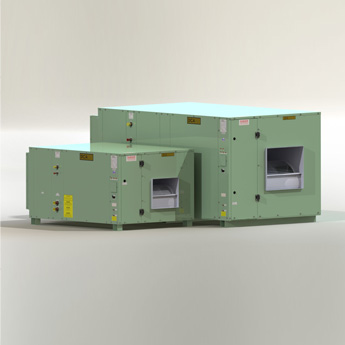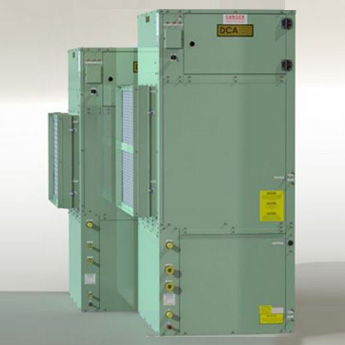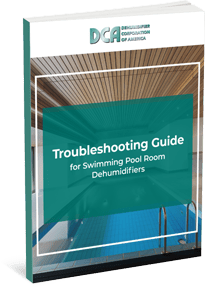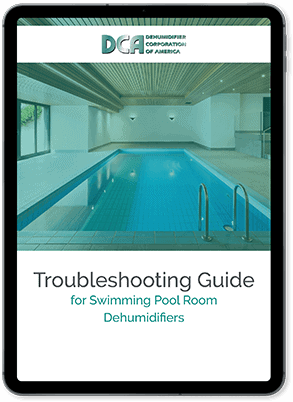Dehumidifiers are needed when the control of relative humidity is critical. They are invaluable for alleviating high humidity, mold, mildew and corrosion that come from poor insulation, high dew point outdoor air, or insufficient control of room temperature. Depending on your specific needs, dehumidifiers are available in residential, commercial, and industrial varieties. While residential dehumidifiers (normally portable and operate on a 115 volt power) are smaller, quieter, and less expensive, they are not suitable for large spaces. In these cases, commercial or industrial models are the better choice.
Differences between Industrial, Commercial, and Residential Dehumidifiers
Residential dehumidifiers are standalone portable machines that operate on 115 volts. Not to be confused with those used for indoor swimming pool and hot tub applications, residential dehumidifiers are commonly used in basements and can be found in most big box stores.
Commercial and industrial dehumidifiers are permanently installed with ductwork, and are designed to operate on any commercial voltage and multi-phase power. While residential units are made from less durable, lightweight plastics, commercial and industrial units are constructed from heavy gauge galvannealed steel, copper, and aluminum.
Dehumidifier Types: Refrigerant and Desiccant Dehumidifiers
The two primary types of dehumidifiers include refrigerant and desiccant. The way refrigerant and desiccant dehumidifiers differ is in the method by which they remove moisture from the surrounding air:
- Refrigerant. When suspended moisture touches a cool surface, it condenses into water. Refrigerant dehumidifiers use a cooled metal plate or evaporator coil to collect condensation.
- Desiccant. A desiccant is a material that can absorb a large amount of moisture. In a desiccant dehumidifier, a wheel of desiccant material rotates slowly, collecting moist air passing through and is then removed by passing through a stream of warm air.
Refrigerant dehumidifiers are effective in achieving dew point temperatures in situations where the room air is 50°F or above; whereas, desiccant dehumidifiers work in lower dew point applications. Since desiccant dehumidifiers are designed to operate in applications of low moisture and dew point requirements they are not suited for high moisture load pool room applications. These two types of dehumidifiers complement each other rather than compete with each other in reality.
Dehumidifier Design Options
DCA dehumidifiers are available with a wide range of design options to suit varying industrial environments and applications, such as:
- Horizontal or vertical configurations. How the duct system is laid out in a room typically determines which configuration is needed. Vertical dehumidifiers are usually positioned on the floor and have a smaller footprint. Horizontal dehumidifiers can be mounted on the floor or suspended from the ceiling and offer more discharge options.
- Rooftop curb mounted units – Normally outdoor applications only
- BMS Controls – BACnet. Our dehumidifiers can operate on a wide array of dedicated state-of-the-art controls or building management systems (BMS) as control points.
- Water-cooled models. Water-cooled dehumidifiers operating in environments accessible to a cold water source can funnel condenser heat into water sources such as heat pump loops, cooling towers, processed water, or municipal water. When these are available, an outdoor remote condenser is not needed, allowing the system to deliver either warm or cool dry air back to the space. When the above water sources are not available any indoor pool can serve this function. The rejected condenser heat is then used to supplement the dedicated pool water heater. An outdoor remote condenser is then added to supply cool dry air back to the room when the room and water temperatures are satisfied. Hotels and motels can take advantage of these systems by controlling humidity in indoor pool and spa rooms and adding warm or cool dry air back to the pool room, taking a load off of the present room HVAC system.
- Room Heating systems. Our dehumidifiers are available with external gas, external electric, or internal hot water heating coils to provide additional room heating and cooling in one package through one duct system.
- Other. Add-ons can also be incorporated for more fine-tuned capabilities, such as dust particle control filters, odor removal systems, and cooling and heating controls for both air and water.
Browse Our
Dehumidifier Catalog
Horizontal and Vertical Dehumidifiers
There are two configuration options from which to choose: horizontal or vertical. The choice is typically determined by existing ductwork and room dimensions.
. DCA Horizontal Dehumidifiers
Our 650 CFM (1.5 nominal ton) to 14,000 CFM (30 nominal tons) horizontal dehumidifiers can be installed indoors or outdoors, at ground level, or on top of a building with either a top or bottom discharge to conform to existing ductwork. Horizontal units are wider and shorter than vertical units.
Advantages include various discharge airflow configurations from top, bottom, or straight thru, and flexible installation options for tight spaces that vary from ceiling suspension to floor and wall mounting. At DCA, we offer the following horizontal dehumidifiers:
. DCA Vertical Dehumidifiers
The 1.5 nominal ton (650 CFM) to 8.0 nominal tons (3600 CFM) vertical dehumidifiers are the preferred choice where floor space is limited but headroom is plentiful. They are generally floor mounted, have a smaller footprint than horizontal units, and are much taller, requiring more headroom to accommodate ductwork. Vertical dehumidifiers can be used in many different applications and, in the case of a replacement, where a previous vertical unit existed. At DCA, we offer the following vertical dehumidifier options:
Other Commercial and Industrial Applications
Common applications for commercial and industrial dehumidifiers include:
- Swimming Pool Rooms (Commercial or Residential)
- Therapy Pool Rooms
- Indoor Fitness Centers
- Indoor Grow Rooms
- Vertical Farming
- Warehouse & Storage
- Outdoor Make Up air
- Food Production
- Pharmaceutical
- Fresh and Waste Water Treatment Plants
- Packaging
- Printing
- Any Application Where The Control of Relative Humidity is Crucial
Contact the Experts at DCA for Quality Dehumidification Solutions
Dehumidifiers help to maintain a safe and comfortable environment, prevent damage to structures and contents, and improve air quality. DCA is an industry leader in dehumidification systems. When you work with us, you can count on the advantages of expert engineers, cutting-edge technology, and a commitment to continuous improvement. Our talented and highly experienced team offers dehumidification solutions tailored to the specifications and individual needs of each project.
Our products are made in America and feature top quality at a competitive price. To learn more about our dehumidifiers, contact us today to request a quote.
Request A Free Project Analysis







